If you are not a pharmacologist or physiologist, you may never have heard of Bernard Ginsborg. I first met him in 1960. He was a huge influence on me and a great friend. I’m publishing this here because the Physiological Society has published only a brief obituary.
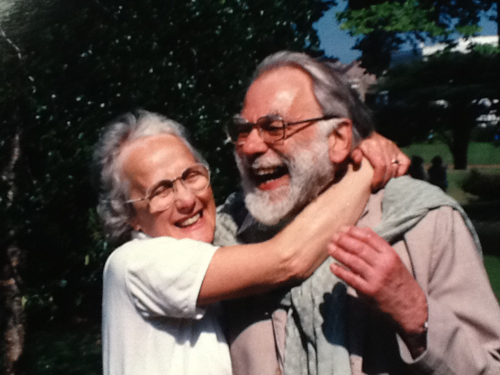
Bernard with his wife, Andy (Andrina).
You can download the following documents.
- Biography written by one of his daughters, Jane Ginsborg.
- Bernard’s scientific work, written by Donald H. Jenkinson (who knew him from his time in Bernard Katz’s Department of Biophysics).
- A tribute by Randall House, who collaborated with Bernard in Edinburgh.
- An obituary by Professor A. Mark Evans, Chair of Cellular Pharmacology, University of Edinburgh.
- Bernard’s obituary in The Times.
- Bernard’s Wikipedia entry.
I’ll post here my own recollections of Bernard here.
Bernard Ginsborg was a lecturer in the Pharmacology department in Edinburgh when I joined that department in 1960, as a PhD student.
I recall vividly our first meeting in the communal tea room: smallish in stature, large beard and umbrella, My first reaction was ‘is this chap ever going to stop talking?’. My second reaction followed quickly: this chap has an intellect like nobody I’d encountered before.
I’d been invited to Edinburgh by Walter Perry, who had been external examiner for my first degrees in Leeds. In my 3rd year viva, he’d asked me to explain the difference between confidence limits and fiducial limits. Of course I couldn’t answer, and spent much of my 4th year trying to find out. I didn’t succeed but produced a paper that most have impressed him. He, together with W.E. Brocklehurst, were my PhD supervisors. I saw Perry only when he dropped into my lab for a cigarette between committee meetings., but he treated me very well. He got me a Scottish Hospitals Endowment Trust scholarship which paid twice the usual MRC salary for a PhD student, and he made me an honorary lecturer so that I could join the magnificent staff club on Chambers Street (now gone), where I met, among many others, Peter Higgs, of boson fame.
I very soon came to wish that Bernard was my supervisor rather than Perry. I loved his quantitative approach. A physicist was more appealing to me than a medic. We spent a lot of time talking and I learnt a huge amount from him. I had encountered some of Bernard Katz’s papers in my 4th undergraduate year, and realised they were something special, but I didn’t know enough about electrophysiology to appreciate them fully. Bernard explained it all to me. His 1967 review, Ion movements in junctional transmission, is a classic: still worth reading by anyone interested in electrophysiology. Bernard’s mathematical ability was invaluable to me when, during my PhD, I was wrestling with the equations for diffusion in a cylinder with binding (see appendix here).
The discussions in the communal tea room were hugely educational. Dick Barlow and R.P. Stephenson were especially interesting, I soon came to realise that Bernard had a better grasp on quantitative ideas about receptors than either of them. His use of Laplace transforms to solve simultaneous differential equations in a 1974 paper was my first introduction to them, and that proved very useful to me later. Those discussions laid the ground for a life-long interest in the topic for me.
After I left the pharmacology department in 1964, contact became more intermittent for a while. I recall vividly a meeting held in Crans sur Sierre, Switzerland in 1977, The meetings there were good, despite have started as golfing holidays for J. Murdoch Ritchie and Joe Hoffman. There was a certain amount of tension between Bernard and Charles F Stevens, the famous US electrophysiologist. Alan Hawkes and I had just postulated that the unitary event in ion channel opening at the neuromuscular junction was a short burst of openings rather than single openings. This contradicted the postulate by Anderson & Stevens (1973) that binding of the agonist was very fast compared with the channel opening and shutting. At the time our argument was theoretical –it wasn’t confirmed experimentally until the early 80s. Bernard was chairing a session and he tried repeatedly to get Stevens to express an opinion on our ideas, but failed.
At dinner, Stevens was holding court: he expressed the view that rich people shouldn’t pay tax because there were too few of them and it cost more to get them pay up than it was worth. He sat back to wait for the angry protestations of the rest of the people at the table, He hadn’t reckoned with Bernard. He said how much he agreed, and by the same token, the police shouldn’t waste time trying to catch murderers. There were too few of them and it wasted too much police time. The argument was put eloquently as only Bernard could do. Stevens, who I suspect had not met Bernard before, was uncharacteristically speechless. He had no idea what hit him. It was a moment to savour.
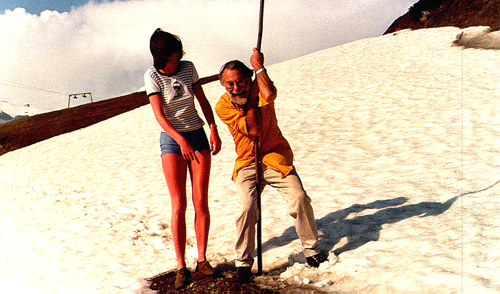
May 1977, Crans sur Sierre, Switzerland.
For those who knew Bernard, it was another example of his ability to argue eloquently for any proposition whatsoever. I’d been impressed by his speech on how the best way to teach about drugs was to teach them in alphabetical order: it would make as much sense as any other way of categorising them. Usually there was just enough truth in these propositions to make the listener who hadn’t heard him in action before, wonder, for a moment, if he was serious. The picture shows him with my wife, Margaret, at the top of a mountain during a break in the meeting. He’d walked up, putting those of us who’d taken the train to shame.
In 1982, Alan Hawkes and I published a paper with the title “On the stochastic properties of bursts of single ion channel openings and of clusters of bursts.” It was 59 pages long with over 400 equations, most of which used matrix notation. After it had been accepted, I discovered that Bernard had taken on the heroic job of reviewing itl This came to light when I got a letter from him that consisted of two matrices which, when multiplied out, revealed his role.
For many years Bernard invited me to Edinburgh to talk to undergraduates about receptors and electrophysiology. (I’ve often wondered if that’s why most of our postdocs came from Glasgow than from Edinburgh during that time.) It was on one such visit in 1984 that I got a phone call to say that my wife, Margaret, had collapsed on the railway station at Walton-on-Thames while 6 months pregnant, and had been taken to St Peter’s Hospital in Chertsey. The psychodrama of our son’s birth has been documented elsewhere, A year later we came to Edinburgh once again. The pictures taken then show Bernard looking impishly happy, as he very often did, in his Edinburgh house in Magdala Crescent. The high rooms were lined with books, all of which he seemed to have read. His intellect was simply dazzling.
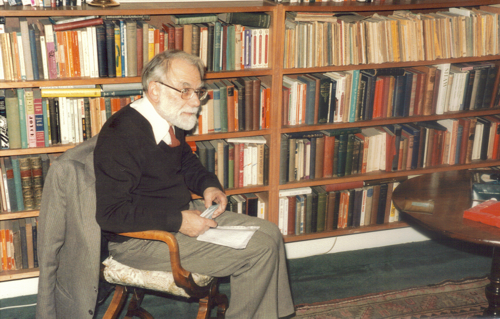
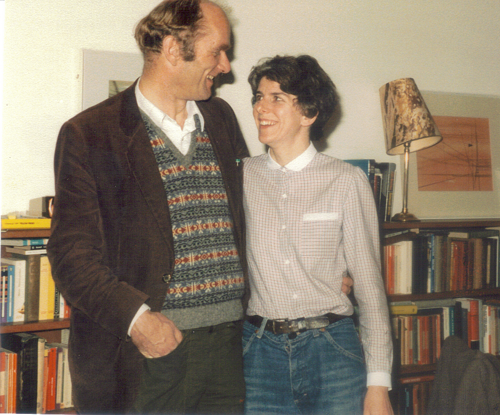
December 19th 1985. Magdala Crescent, Edinburgh
The following spring we visited again, this time with our son Andrew, aged around 15 months. We went with Bernard and Andy to the Edinburgh Botanic gardens. Andrew who was still not walking, crawled away rapidly up a grassy slope. Andy said don’t worry, when he gets to the tope he’ll stop and look back for you. She was a child psychologist so we believed her. Andrew, however, disappeared from sight over the brow of the hill.
During these visits, we stayed with Bernard and Andy at their Edinburgh house.
The experience of staying with them was like being exposed to an effervescent intellectual fountain. It’s hard to think of a better matched couple.
After Bernard retired in 1985, he took no further interest in science. For him, it was a chance to spend time on his many other interests. After he went to live in France, contact became more intermittent. Occasional emails were exchanged. It was devastating to hear about the death of Andy in 2013. The last time that I saw both of them was in 2008, at John Kelly’s house. He was barely changed from the day that I met him in 1960.
Bernard was a legend. It’s hard to believe that he’s no longer here.
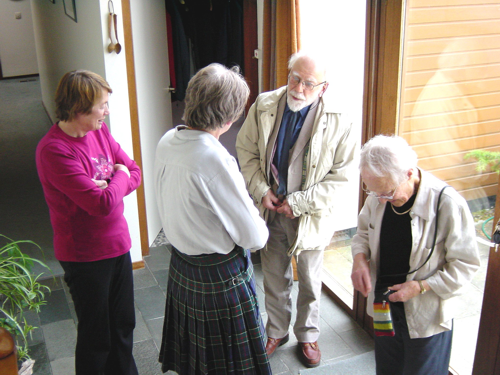
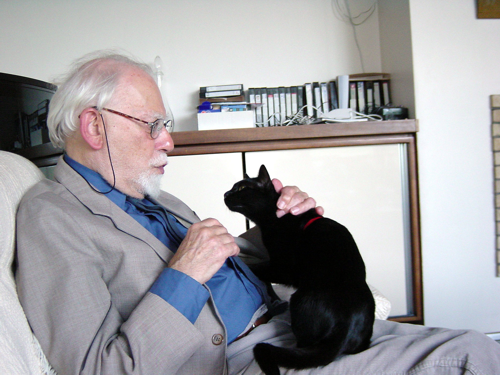
Bernard in 2008 at John Kelly’s house.
Lastly, here is a picture taken at the 2009 meeting of the British Pharmacological Society, held in Edinburgh.
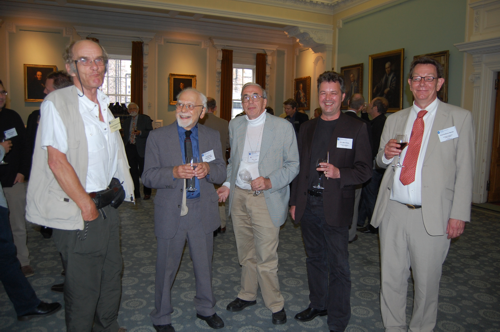
At the British Pharm. Soc meeting, 2009.Left to right: DC, BLG, John Kelly, Mark Evans, Anthony Harmer


Leave a Reply